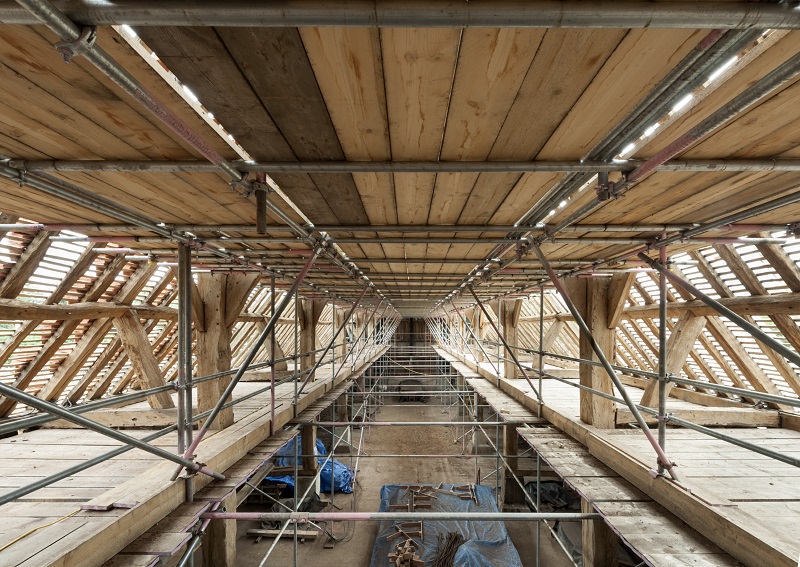Temporary Roof Scaffolding to Ensure Safe Working Conditions During Projects
Temporary Roof Scaffolding to Ensure Safe Working Conditions During Projects
Blog Article
Finding the Advantages of Scaffolding for Specialists and Construction Employees
The execution of scaffolding in building and construction tasks offers as a vital aspect for improving operational performance and security. The full range of scaffolding's advantages prolongs past plain functionality and safety-- there are deeper ramifications that necessitate further expedition.

Enhanced Employee Security
Boosted employee safety and security is a paramount worry in the building and construction sector, specifically when it pertains to the use of scaffolding. Correctly designed and installed scaffolding systems provide crucial assistance for workers operating at elevations, considerably reducing the risk of drops, which are amongst the leading root causes of casualties in construction.
Scaffolding improves safety through its architectural honesty and style functions that enable secure job systems. High-quality scaffolding products, such as steel or light weight aluminum, offer resilience and stamina, making sure that they can endure the weight and motion of products and workers. In addition, precaution such as guardrails, toe boards, and gain access to ladders are important elements that protect against accidents and injuries.
Normal assessments and maintenance of scaffolding are vital to promote safety and security criteria. Building supervisors need to guarantee that employees are effectively learnt scaffold use and safety and security protocols, highlighting the significance of adhering to established guidelines. This extensive technique not just safeguards employees however likewise fosters a culture of safety within the organization. Investing in proper scaffolding options is not merely a regulatory need; it is an essential facet of promoting a safe and secure working atmosphere in the building market.
Enhanced Availability
Access in the building market is important for promoting performance and productivity on task websites. Scaffolding offers a functional service that substantially enhances accessibility for contractors and building employees. By supplying steady systems at different heights, scaffolding enables workers to get to raised areas securely and successfully, decreasing the need for cumbersome ladders or uncomfortable settings that can impede development.
The design of scaffolding systems permits for easy activity of materials, workers, and tools, enhancing process and lessening delays. With correct scaffolding in place, workers can work together better, as several staff member can run concurrently in a constrained area without compromising safety or access. This adaptability is especially beneficial in complex building tasks that require regular adjustments in elevation or position.
Moreover, scaffolding can be tailored to fit specific project requirements, guaranteeing that all areas are accessible no matter the structure's style. By enhancing accessibility, scaffolding not only enhances the workplace yet likewise contributes to a more orderly website, thus advertising a society of effectiveness and safety. In recap, enhanced ease of access with scaffolding is a crucial variable in enhancing the performance of building teams.
Raised Efficiency
The execution of scaffolding not just enhances availability yet additionally plays a substantial function in raising performance on construction sites. By providing a stable and safe platform, scaffolding permits employees to carry out tasks at height with better ease and safety (Temporary Roof Scaffolding).
Furthermore, scaffolding allows numerous trades to function concurrently, enhancing cooperation and accelerating task timelines. As an example, while one crew is setting up electric systems, another can deal with plumbing or finishing jobs on the same level, reducing downtime. The tactical format of scaffolding also assists in quicker movement across the website, getting rid of the requirement for constant altitude changes or too much ladder usage.

Cost-Effectiveness
While many might originally perceive scaffolding as an extra expense, its application really contributes to substantial cost-effectiveness on building and construction projects. By assisting in more secure and much more efficient job atmospheres, scaffolding reduces the risks of injuries and mishaps, which can cause pricey delays and increased insurance policy costs.
Additionally, scaffolding enhances performance by offering employees with instant accessibility to multiple levels of a structure. This ease of access not only accelerates the speed of construction but also decreases labor costs, as workers can complete tasks more promptly without the demand for difficult ladders or lifts.
Additionally, the modular nature of scaffolding allows for flexibility in its usage throughout numerous tasks, leading to lowered rental costs when compared to much less versatile alternatives. The ability to recycle scaffolding for different jobs better amplifies its cost-effectiveness, guaranteeing a higher return on financial investment.
Convenience in Applications
Frequently recognized for its adaptability, scaffolding offers a large range of applications in the building and construction sector. Its convenience allows for usage in different jobs, from domestic structures to large-scale business advancements. Scaffolding systems can be personalized to fit various website problems, accommodating one-of-a-kind architectural layouts and elevations.
Along with traditional construction, scaffolding is additionally invaluable for repair and maintenance jobs. Whether it entails painting, window installation, or facade restoration, scaffolding provides a steady system that enhances worker safety and efficiency. Its modular design permits for quick setting up and disassembly, making it perfect for tasks with tight timelines.
Furthermore, scaffolding is not limited to upright structures; it can be efficiently used in bridge building and construction, industrial facilities, and also short-lived event areas. The capacity to adapt scaffolding for different environments guarantees that professionals can satisfy diverse job demands without compromising safety or ease of access.
This multifunctionality underscores the importance of scaffolding in modern-day construction practices, making it possible for service providers and building employees to perform their jobs with higher flexibility and precision. Inevitably, the convenience of scaffolding contributes substantially to the general success of building projects throughout different fields.

Conclusion
In recap, the advantages of scaffolding for service providers and building and construction workers are considerable. The flexibility in applications permits scaffolding to adapt to different task requirements.
The implementation of scaffolding in construction projects offers as an important element for enhancing functional performance and safety and security. Scaffolding offers a flexible remedy that substantially boosts scaffold drawing accessibility for service providers and construction workers. In recap, improved availability via scaffolding is an essential factor in optimizing the efficiency of building and construction groups.
The implementation of scaffolding not only boosts ease of access however also scaffolders insurance plays a significant role in raising performance on building and construction websites. Temporary Roof Scaffolding.In recap, the advantages of scaffolding for contractors and construction workers are substantial
Report this page